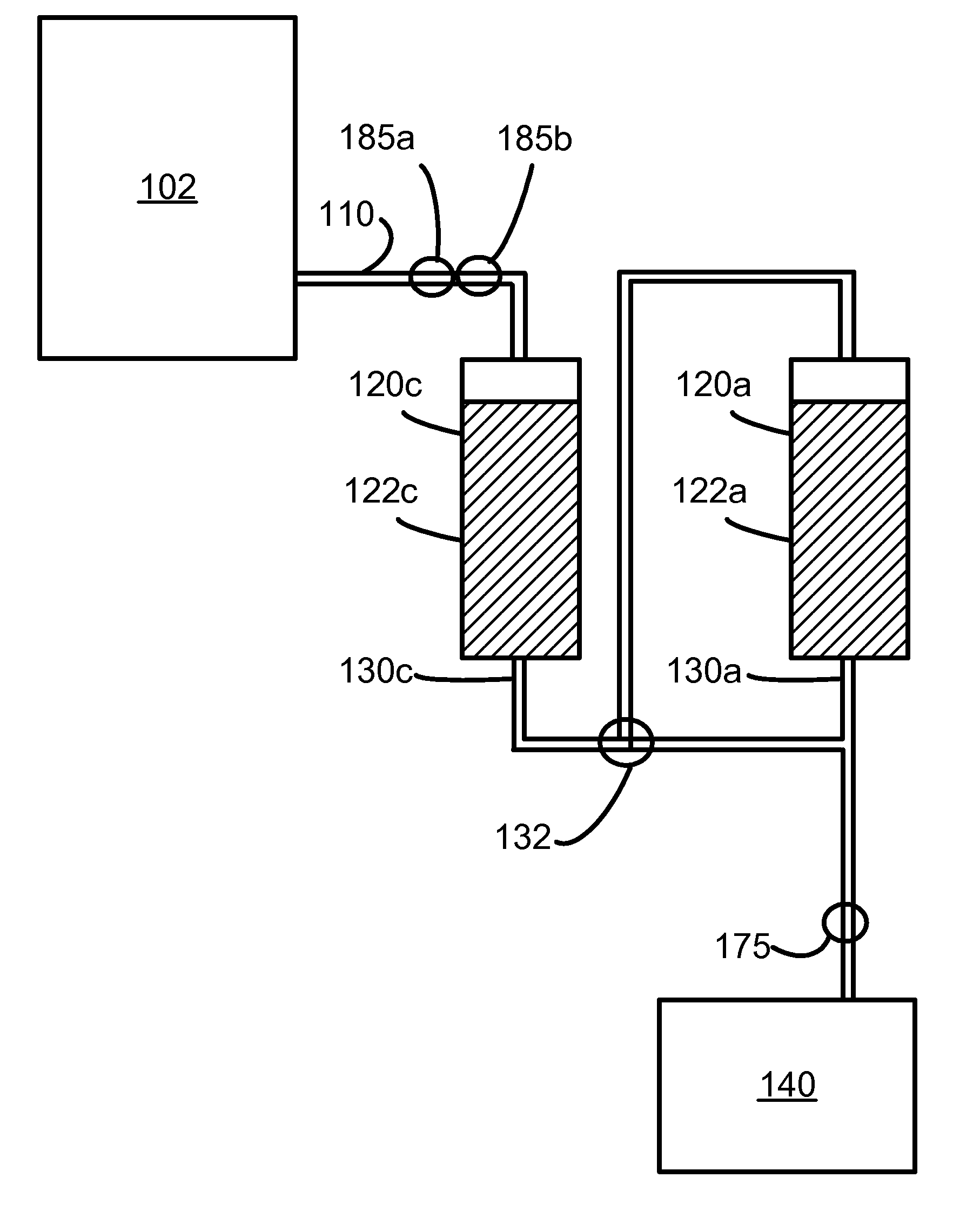Sucrose inversion process
a technology of inversion process and sucrose, which is applied in the field of sugar processing, can solve the problems of inconvenient handling and processing, crystallization of sucrose, and undesirable properties of sucrose solution used directly after extraction from sugarcane or sugar beet, and achieves the effect of convenient control and efficient inversion of sucros
- Summary
- Abstract
- Description
- Claims
- Application Information
AI Technical Summary
Benefits of technology
Problems solved by technology
Method used
Image
Examples
example 1
[0089]A commercial-scale sucrose inversion system, having a total resin bed volume of 2.6 m3, was modeled with an aqueous sucrose solution having known quantity and type of ash. Initial conditions were:
[0090]
Feed flow rateFeed flowm3 / hrBV / hrTemp / C.8.93.538.00
[0091]After 7 hr, by performing calculations based on the above parameters, the known ash properties, and known resin properties, the activity remaining in the resin was calculated. Also, the mass and inversion percentage of the product were determined on a dry solids (DS) basis:
[0092]
Final flowFinal steprate on activeFinal activeWeight finalproductresinresin% activeproductcumulativeBV / hrm3resintonnes DS% inversion4.791.8673%48.153%
[0093]At 7 hr, the feed flow rate and temperature were adjusted:
[0094]
Feed flow rateFeed flowm3 / hrBV / hrTemp / C.5.22.036.00
[0095]At 14.4 hr total (7.4 hr after adjustment), resin activity was calculated and the mass and inversion percentage of the product were determined:
[0096]
Final flowFinal steprate o...
example 2
[0101]A commercial-scale sucrose inversion system, having a total resin bed volume of 2.55 m3, was modeled with an aqueous sucrose solution having known quantity and type of ash. Initial conditions were:
[0102]
Feed flow rateFeed flowm3 / hrBV / hrTemp / C.8.93.537.50
[0103]A total of four steps (initial conditions and three adjustments) were performed during the run, as follows:
[0104]
Final flowFinalWeightFinal stepFeedSteprate onactive%finalproductflowtimeactive resinresinactiveproductcumulative %StepBV / hrTemp / C.hrBV / hrm3resintonnes DSinversion13.537.504.34.192.1384%29.653%22.135.004.32.841.8874%17.753%31.132.505.91.651.7167%12.853%40.330.2560.521.6665%453%
[0105]Instantaneous inversion at various time points was measured:
[0106]
StepTotal runInstantaneousSteptime / hrstime / hrs% inversionBV / hrTemp / ° C.10054.93.5037.511154.23.5037.513352.63.5037.514.34.351.43.5037.5204.354.22.1035215.353.82.1035237.353.12.103524.38.652.52.1035308.653.51.1032.5319.653.41.1032.53210.653.31.1032.535.914.552.81.1032....
example 3
[0109]A commercial-scale sucrose inversion system, having a total resin bed volume of 2.55 m3, was modeled with an aqueous sucrose solution having known quantity and type of ash. Initial conditions were:
[0110]
Feed flow rateFeed flowm3 / hrBV / hrTemp / C.7.64336
[0111]The feed flow was adjusted at various times during the run, but the temperature was held constant. A total of four steps (initial conditions and three adjustments) were performed during the run, as follows:
[0112]
FeedFinal flowFinalFinal stepflowFeedRunrate onactiveWeight finalproduct% onflowtimeactive resinresin% activeproductcumulative %StepinitialBV / hrhrBV / hrm3resintonnes DSinversion1100%3.004.33.52.1986%25.453%286%2.584.33.51.8874%2453%373%2.204.83.51.6163%20.953%463%1.884.83.51.3854%17.953%
[0113]The modeling run was summarized as follows:
[0114]
OutputsTotal run time / hr18.2Total DS product / tonnes88.2Total product @ 60DS / tonnes147Final % inversion of product53%mixInvert produced per4.85hour / tonnes DS
PUM
| Property | Measurement | Unit |
|---|---|---|
| temperature | aaaaa | aaaaa |
| temperature | aaaaa | aaaaa |
| temperature | aaaaa | aaaaa |
Abstract
Description
Claims
Application Information
 Login to View More
Login to View More - R&D
- Intellectual Property
- Life Sciences
- Materials
- Tech Scout
- Unparalleled Data Quality
- Higher Quality Content
- 60% Fewer Hallucinations
Browse by: Latest US Patents, China's latest patents, Technical Efficacy Thesaurus, Application Domain, Technology Topic, Popular Technical Reports.
© 2025 PatSnap. All rights reserved.Legal|Privacy policy|Modern Slavery Act Transparency Statement|Sitemap|About US| Contact US: help@patsnap.com



